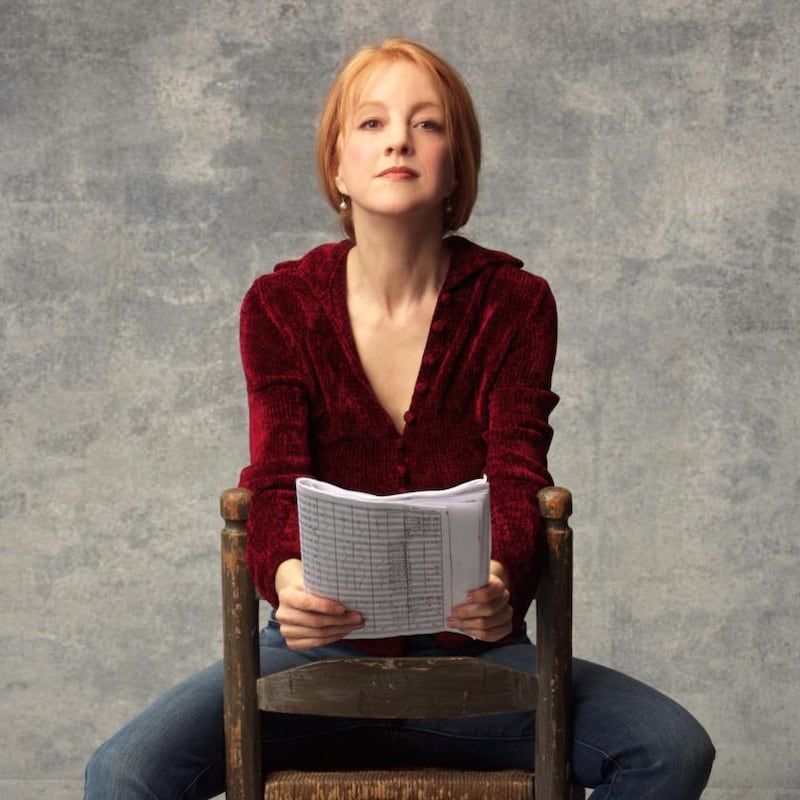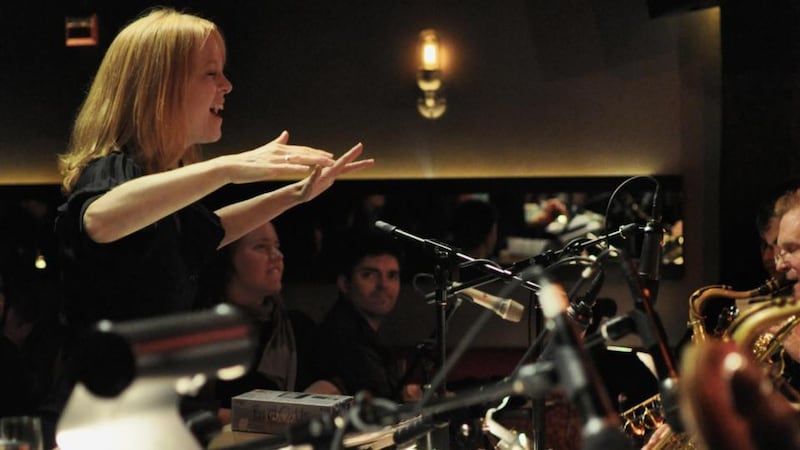Maria Schneider is really pissed off. It’s an unexpected confession from a composer whose “pretty pastoral music” (her own words) speaks with such warmth and humanity, has won her five Grammys and, just this year, the prestigious NEA Jazz Masters award. It is music that, over the last three decades, has made her one of the most respected composers in contemporary jazz. Schneider? Pissed off? Surely not.
“Everything in life comes out when you sit down to write music, and lately, a lot of my life has been obsessing, you know, involuntarily, about Google, and all this big data stuff, just feeling trapped in the world of email, this world that I feel takes such advantage of us in so many ways. So the pretty pastoral is now slowly starting to make way for the, you know, ‘I’m really pissed off’. Actually, I’m more than pissed off, I’m creeped out, and my music is starting to express that.”
Born in 1960 in Windom, a small town in rural Minnesota, Schneider spent her childhood surrounded by the spreading fields and infinite skies of the American midwest. It is that landscape, and the plain-spoken simplicity and directness of midwesterners, that she has tenderly evoked on award-winning albums like Sky Blue (2007) and The Thompson Fields (2015).
My records cost about $200,000 to make. If I had my music on Spotify, maybe I would make $8, maybe I'd make $101. It wouldn't make a dent in a $200,000 budget
The Maria Schneider Orchestra, which features some of the leading instrumental voices of the contemporary American scene, is perhaps the most highly regarded and influential large ensemble in jazz, while Schneider leads the busy life of a successful jazz musician, directing her band, organising rehearsals, touring the world as a guest conductor and giving masterclasses to the next generation of composers and arrangers.
But lately, as the financial returns for jazz artists from their recording have come under increasing pressure, Schneider’s career-long advocacy for artists’ rights has come more to the fore. She has become a clarion voice for a better deal for musicians from the recording industry, testifying before Congress on behalf of the National Academy of Recording Arts and Sciences, writing eloquent open letters to government officials and generally raising a stink about the ever-diminishing returns for those who record creative, non-commercial music.
“On Spotify and all these [streaming] sites,” she says, “I’ve asked around and I’m sure there isn’t one classical, jazz, world, folk, or blues album that has made even a tiny fraction of its budget back. There’s no way, because we all have much smaller niche audiences. Ninety per cent of the music on Spotify gets one per cent of the financial pie that they’re splitting up. This is ridiculous! For me, my records cost about $200,000 to make. If I had my music on Spotify, I don’t know, maybe I would make $8, maybe I’d make $101, I don’t know, but I do know that it wouldn’t even make a dent in a $200,000 budget. So what’s going to happen to these genres of music, what’s going to happen?”

The bomb shelter
In the early noughties, Schneider began working with ArtistShare, one of the first record labels to use fan-funding to finance recordings, and she has become one of the label's star performers. Artists receive 85 per cent of the gross sales from their albums, and in return for their upfront investment, funders get a unique insight into the creative process – and the satisfaction of knowing that the majority of their investment is going directly to the artists. In 2005, Schneider's Concert in the Garden became the first album to win a Grammy without being available in conventional retail outlets.
In that and other recordings – Winter Morning Walks, a collaboration with soprano Dawn Upshaw, netted her another Grammy in 2014 – Schneider has assiduously mined that rich seam of memory connected to Windom and the simplicity of a rural midwestern upbringing. But even here, there is an edge. Compositions like Bomb Shelter Beast and Night Watchman on her second album, Coming About, hinted at a darker side to her childhood.
“It wasn’t like it was all Pollyanna, all sweetness,” she agrees. “There was a good share of tension too. I spent a lot of time being scared, really scared as a kid. At that time, it was the Cold War, there was the Vietnam War going on, and there was the fear of atom bombs. My father built a bomb shelter in our house, and the door was right next to my bed, and it was really creepy.”
Sometimes I think what would happen if I just ditched my life and gave young kids inspiration to understand the importance of creativity and how it makes them feel alive
A much-loved piano teacher in Windom introduced her to jazz, and from an early age, the life of a musician beckoned, so it was inevitable that she would someday make her way to the big city.
“I just always fantasised that some talent scout would hear me and take me away, because of the music, that was just an ongoing ridiculous fantasy. But I loved Windom. I loved my friends. I loved the town. I still love the town. I’m still close to my friends. There’s a building that’s for sale on the square in Windom right now, and part of me fantasises about buying that building and creating some kind of music and art school for people in Windom. Sometimes I think what would happen if I just ditched my life and did that, and gave young kids inspiration, not necessarily to become musicians and artists but to become the kind of people that understand the importance of creativity and how it makes them feel alive. So I still have a big connection to Windom.”
But a town of barely 5,000 souls was never going to provide much of a living for a jazz musician, and with a degree in music theory and composition from the University of Minnesota in her pocket, she made her way east. She still vividly remembers the moment, three decades ago, when she arrived in New York.
“I happened to fly into New York on the best flight route, and I saw the city from the air, and my heart was just beating out of my chest. I just knew at that moment ‘that’s my city, I’m going to live there’. And then I went to the Village Vanguard and heard Zoot Sims, and I was so excited, and at that point, there was no turning back.”

Value of boredom
Her skill as a music copyist soon found her work and she spent the late 1980s apprenticed to two of the giants of big band jazz arranging, Gil Evans and Bob Brookmeyer. Her first album, Evanescence (1994), paid explicit homage to Evans, even as it announced the arrival of a new voice in jazz composition, a feminine voice that seemed to prioritise the communal over the individual. In 1992, she began leading her own orchestra in a weekly residency in Greenwich Village, and it's a testament to her charisma as a leader, and her faithfulness to her community of musicians, that the band that formed around her then is still largely in tact. Several of the musicians she brings with her to the Cork jazz festival this year appeared on that debut album, including bassist Jay Anderson, guitarist Ben Monder and saxophonist Rich Perry.
In person (we’re talking via Skype), Schneider is open and friendly, quick to laugh and happy to talk about her own creative process in detail. But a certain distrust of technology is never far away.
“I don’t even have music notation software,” she says brightly. “I give my scores to somebody else to copy on computer. For me as a composer, a lot of my pieces, they have sort of a flow and development to them, I want them to feel organic, like Gaudi architecture, where it’s not just right angles and rooms and squares and boxes.”
“I really need that process of doing development on sketch paper, and when I see what students are writing these days, I can immediately tell these kids are working directly into a computer. It’s a crutch, and it gives them fast results, but it doesn’t give them good results.”
What I'm concerned about is that when technology is used to make people addicted, to use a crutch, it takes away from quality, from humanness. That's what concerns me
But she protests that it’s not really a case of being enamoured with the pre-technological world of her youth.
“What I’m concerned about is when the technology is used to make people addicted, to use a crutch, it takes away from quality, from humanness. That’s what concerns me. I sit on the subway and I can’t find one person that’s actually reading a book, or just looking around. Everyone is just immersed in these little devices. And you know that they are using some app that was designed to make them addicted to that app.”
It’s a subject that comes up frequently in her masterclasses, and her advice to would-be composers is to rediscover the value of boredom.
“I say to them ‘the first thing is, you see the cell phones you all have, you have to be willing to turn that thing off, because that thing is constantly wanting your attention, every app on there is fighting for it to make you addicted. Unless you are willing to sit in silence, willing to face boredom, you can’t ignite your imagination. You need space, uncomfortable space, in order for ideas to start to bubble up, so that you feel your own ideas come alive’.”
She says her next project for ArtistShare will be a mix of old and new, some, like her composition Data Lords, channeling her rage about big data, but others still mining that rich midwestern seam.
“I feel that when I play a lot of my music, I go home. I think it’s the openness, the big sky, the plainness of the message. You know in Minnesota, people are plain spoke, they don’t speak in a lot of fancy, erudite language, pretty much what you see is what you get. I think my music is pretty direct in its message. I don’t try to create music that is difficult. I don’t think my music is necessarily easy music, but I don’t think it’s hard to decipher. I want people to sit there and be taken somewhere. They don’t have to think. They just should sit and feel.”
“But,” she adds laughing, “if they want to think, hopefully there’s plenty for them to think about too!”












